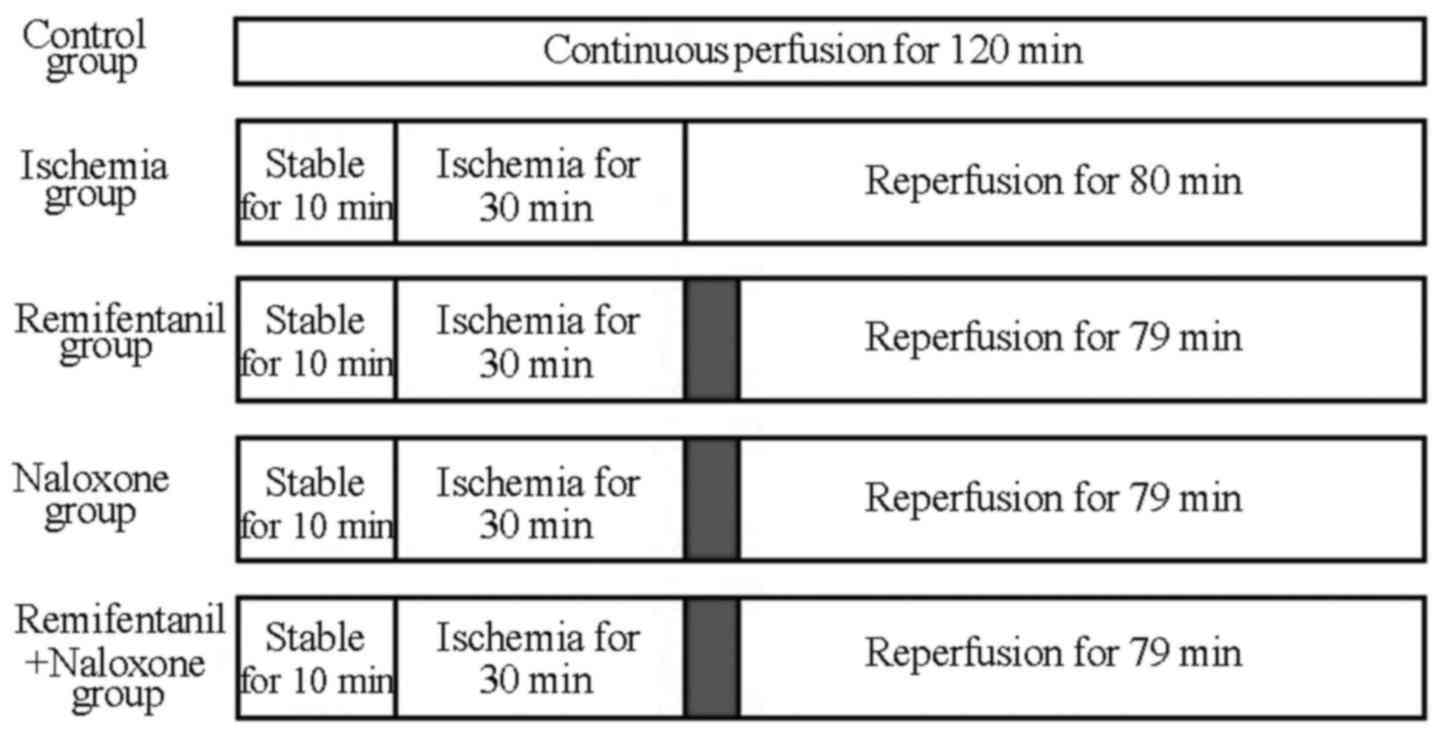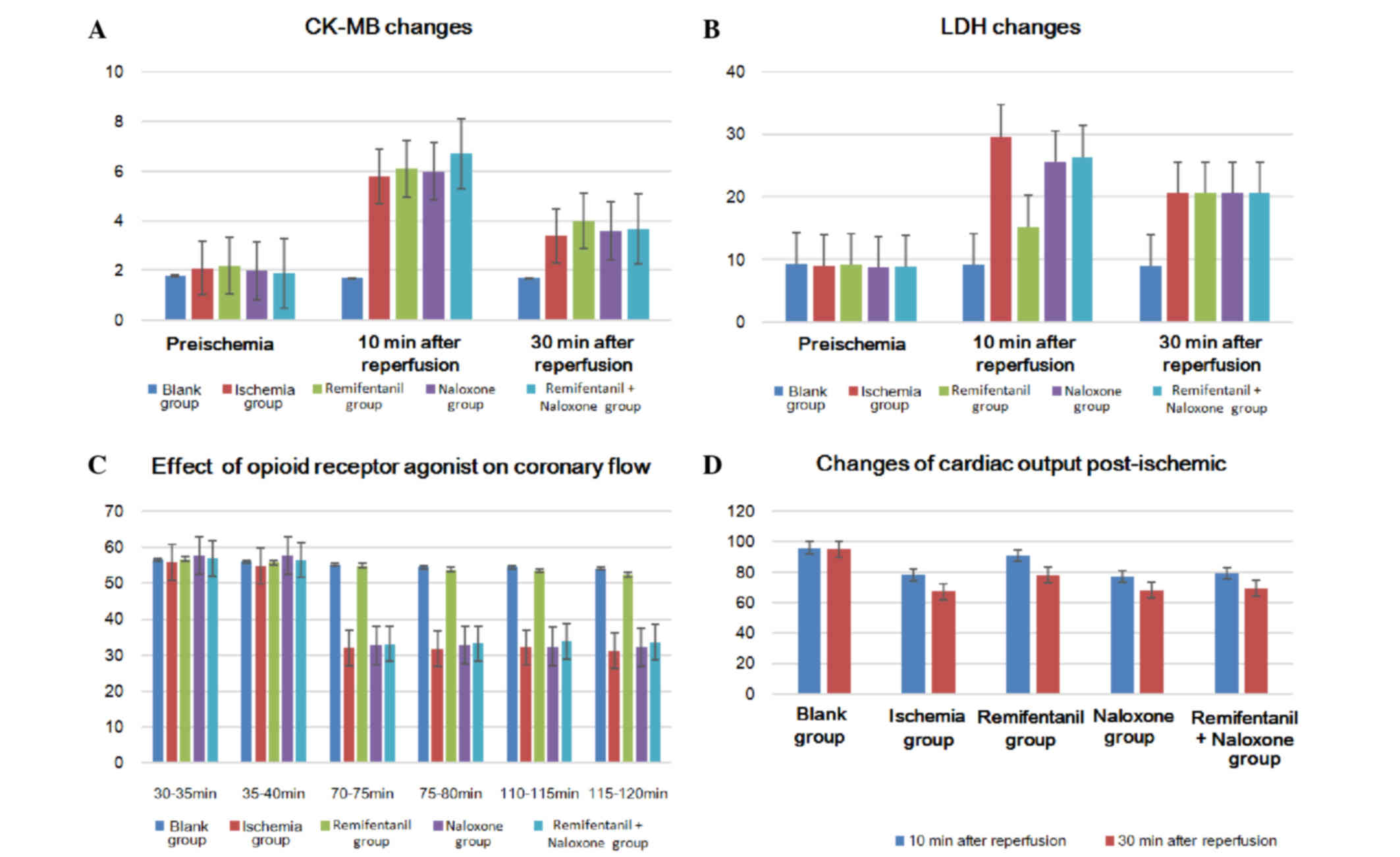|
1
|
Carden DL and Granger DN: Pathophysiology
of ischaemia-reperfusion injury. J Pathol. 190:255–266. 2000.
View Article : Google Scholar : PubMed/NCBI
|
|
2
|
Naito H, Furukawa Y, Chino D, Yamada C and
Hashimoto K: Effects of zatebradine and propranolol on canine
ischemia and reperfusion-induced arrhythmias. Eur J Pharmacol.
388:171–176. 2000. View Article : Google Scholar : PubMed/NCBI
|
|
3
|
Murry CE, Jennings RB and Reimer KA:
Preconditioning with ischemia: A delay of lethal cell injury in
ischemic myocardium. Circulation. 74:1124–1136. 1986. View Article : Google Scholar : PubMed/NCBI
|
|
4
|
Miura T, Miura T, Kawamura S, Goto M,
Sakamoto J, Tsuchida A, Matsuzaki M and Shimamoto K: Effect of
protein kinase C inhibitors on cardioprotection by ischemic
preconditioning depends on the number of preconditioning episodes.
Cardiovasc Res. 37:700–709. 1998. View Article : Google Scholar : PubMed/NCBI
|
|
5
|
Zhao ZQ, Corvera JS, Halkos ME, Kerendi F,
Wang NP, Guyton RA and Vinten-Johansen J: Inhibition of myocardial
injury by ischemic postconditioning during reperfusion: Comparison
with ischemic preconditioning. Am J Physiol Heart Circ Physiol.
285:H579–H588. 2003. View Article : Google Scholar : PubMed/NCBI
|
|
6
|
Jennings RB: Historical perspective on the
pathology of myocardial ischemia/reperfusion injury. Circ Res.
113:428–438. 2013. View Article : Google Scholar : PubMed/NCBI
|
|
7
|
Hausenloy DJ: Cardioprotection techniques:
Preconditioning, postconditioning and remote conditioning (basic
science). Curr Pharm Des. 19:4544–4563. 2013. View Article : Google Scholar : PubMed/NCBI
|
|
8
|
Umegaki H and Tagami N: Anesthetic
management of an ALS patient with remifentanil. Masui.
57:1139–1142. 2008.(In Japanese). PubMed/NCBI
|
|
9
|
Zhang G, Sun Y, Wang Y, Bai J, Li T, Li X,
Su S and Liu X: An improved postconditioning algorithm: Gradually
increased reperfusion provides improved cardioprotection in rats.
Mol Med Rep. 8:696–702. 2013.PubMed/NCBI
|
|
10
|
Finegan BA, Gandhi M and Clanachan AS:
Phentolamine prevents the adverse effects of adenosine on
glycolysis and mechanical function in isolated working rat hearts
subjected to antecedent ischemia. J Mol Cell Cardiol. 32:1075–1086.
2000. View Article : Google Scholar : PubMed/NCBI
|
|
11
|
Flameng W, Borgers M, Daenen W and
Stalpaert G: Ultrastrutural and cytochemical correlates of
myocardial protection by cardiac hypothermia in man. J Thorac
Cardiovasc Surg. 79:413–424. 1980.PubMed/NCBI
|
|
12
|
Tong G, Aponte AM, Kohr MJ, Steenbergen C,
Murphy E and Sun J: Postconditioning leads to an increase in
protein S-nitrosylation. Am J Physiol Heart Circ Physiol.
306:H825–H832. 2014. View Article : Google Scholar : PubMed/NCBI
|
|
13
|
Sun K, Liu ZS and Sun Q: Role of
mitochondria in cell apoptosis during hepatic ischemia-reperfusion
injury and protective effect of ischemic postconditioning. World J
Gastroenterol. 10:1934–1938. 2004. View Article : Google Scholar : PubMed/NCBI
|
|
14
|
Tsang A, Hausenloy DJ, Mocanu MM and
Yellon DM: Postconditioning: A form of ‘modified reperfusion’
protects the myocardium by activating the phosphatidylinositol
3-kinase-Akt pathway. Circ Res. 95:230–232. 2004. View Article : Google Scholar : PubMed/NCBI
|
|
15
|
Zhao Q, Shao L, Hu X, Wu G, Du J, Xia J
and Qiu H: Lipoxin a4 preconditioning and postconditioning protect
myocardial ischemia/reperfusion injury in rats. Mediators Inflamm.
2013:2313512013. View Article : Google Scholar : PubMed/NCBI
|
|
16
|
Vinten-Johansen J, Zhao ZQ, Zatta AJ, Kin
H, Halkos ME and Kerendi F: Postconditioning - A new link in
nature's armor against myocardial ischemia-reperfusion injury.
Basic Res Cardiol. 100:295–310. 2005. View Article : Google Scholar : PubMed/NCBI
|
|
17
|
Zhao TC, Du J, Zhuang S, Liu P and Zhang
LX: HDAC inhibition elicits myocardial protective effect through
modulation of MKK3/Akt-1. PLoS One. 8:e654742013. View Article : Google Scholar : PubMed/NCBI
|
|
18
|
Takata K, Tomiyama Y, Tanaka K and Oshita
S: Cardioprotective effects of hyperkalemia during simulated
ischemia/reperfusion in neonatal rat cardiomyocytes - Preservation
of Na+/K+-ATPase activity. J Med Invest. 60:66–76. 2013. View Article : Google Scholar : PubMed/NCBI
|
|
19
|
Babiker FA, Joseph S and Juggi J: The
protective effects of 17beta-estradiol against ischemia-reperfusion
injury and its effect on pacing postconditioning protection to the
heart. J Physiol Biochem. 70:151–162. 2014. View Article : Google Scholar : PubMed/NCBI
|
|
20
|
Kin H, Zatta AJ and Jiang R: Activation of
opioid receptors mediates the infarct postconditioning. J Mol Cell
Cardiol. 38:8272005.
|
|
21
|
Yellon DM and Hausenloy DJ: Myocardial
reperfusion injury. N Engl J Med. 357:1121–1135. 2007. View Article : Google Scholar : PubMed/NCBI
|
|
22
|
Widgerow AD: Ischemia-reperfusion injury:
Influencing the microcirculatory and cellular environment. Ann
Plast Surg. 72:253–260. 2014. View Article : Google Scholar : PubMed/NCBI
|
|
23
|
Perrelli MG, Tullio F, Angotti C, Cerra
MC, Angelone T, Tota B, Alloatti G, Penna C and Pagliaro P:
Catestatin reduces myocardial ischaemia/reperfusion injury:
Involvement of PI3K/Akt, PKCs, mitochondrial KATP channels and ROS
signalling. Pflugers Arch. 465:1031–1040. 2013. View Article : Google Scholar : PubMed/NCBI
|
|
24
|
Cui J, Li Z, Qian LB, Gao Q, Wang J, Xue
M, Lou XE, Bruce IC, Xia Q and Wang HP: Reducing the oxidative
stress mediates the cardioprotection of bicyclol against
ischemia-reperfusion injury in rats. J Zhejiang Univ Sci B.
14:487–495. 2013. View Article : Google Scholar : PubMed/NCBI
|
|
25
|
Argaud L, Gateau-Roesch O, Raisky O,
Loufouat J, Robert D and Ovize M: Postconditioning inhibits
mitochondrial permeability transition. Circulation. 111:194–197.
2005. View Article : Google Scholar : PubMed/NCBI
|
|
26
|
Di Benedetto G, Scalzotto E, Mongillo M
and Pozzan T: Mitochondrial Ca2+ uptake induces cyclic AMP
generation in the matrix and modulates organelle ATP levels. Cell
Metab. 17:965–975. 2013. View Article : Google Scholar : PubMed/NCBI
|
|
27
|
Staat P, Rioufol G, Piot C, Cottin Y, Cung
TT, L'Huillier I, Aupetit JF, Bonnefoy E, Finet G, André-Fouët X
and Ovize M: Postconditioning the human heart. Circulation.
112:2143–2148. 2005. View Article : Google Scholar : PubMed/NCBI
|
|
28
|
Maslov LN, Naryzhnaia NV, Hanuš L, Pei JM,
Baĭkov AN, Zhang I, Wang H and Khaliulin IG: Problem of
end-effector of ischemic postconditioning of the heart. Ross Fiziol
Zh Im I M Sechenova. 99:555–574. 2013.(In Russian). PubMed/NCBI
|
|
29
|
Yang XM, Proctor JB, Cui L, Krieg T,
Downey JM and Cohen MV: Multiple, brief coronary occlusions during
early reperfusion protect rabbit hearts by targeting cell signaling
pathways. J Am Coll Cardiol. 44:1103–1110. 2004. View Article : Google Scholar : PubMed/NCBI
|
|
30
|
Bround MJ, Wambolt R, Luciani DS, Kulpa
JE, Rodrigues B, Brownsey RW, Allard MF and Johnson JD:
Cardiomyocyte ATP production, metabolic flexibility, and survival
require calcium flux through cardiac ryanodine receptors in vivo. J
Biol Chem. 288:18975–18986. 2013. View Article : Google Scholar : PubMed/NCBI
|
|
31
|
Darling CE, Jiang R, Maynard M, Whittaker
P, Vinten-Johansen J and Przyklenk K: Postconditioning via
stuttering reperfusion limits myocardial infarct size in rabbit
hearts: Role of ERK1/2. Am J Physiol Heart Circ Physiol.
289:H1618–H1626. 2005. View Article : Google Scholar : PubMed/NCBI
|












